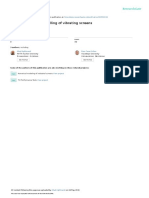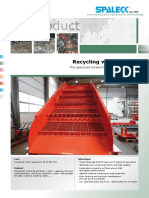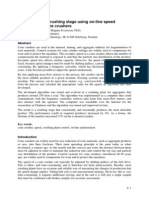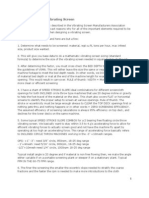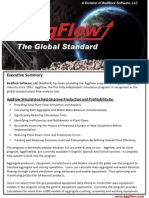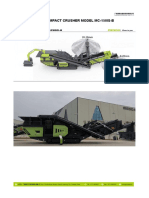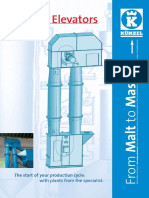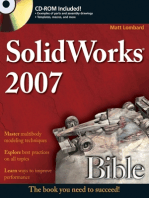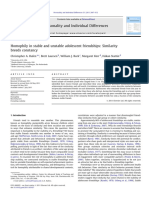The Size Separation of Particles by Screening: The The Various Tj-Pes Are Reviewed. Random Path
The Size Separation of Particles by Screening: The The Various Tj-Pes Are Reviewed. Random Path
Uploaded by
Heidy MarinnaCopyright:
Available Formats
The Size Separation of Particles by Screening: The The Various Tj-Pes Are Reviewed. Random Path
The Size Separation of Particles by Screening: The The Various Tj-Pes Are Reviewed. Random Path
Uploaded by
Heidy MarinnaOriginal Description:
Original Title
Copyright
Available Formats
Share this document
Did you find this document useful?
Is this content inappropriate?
Copyright:
Available Formats
The Size Separation of Particles by Screening: The The Various Tj-Pes Are Reviewed. Random Path
The Size Separation of Particles by Screening: The The Various Tj-Pes Are Reviewed. Random Path
Uploaded by
Heidy MarinnaCopyright:
Available Formats
The Size Separation of Particles by Screening
M. L. JANSEN Ah7, J. R. GLASTONBURY
Deparrmenr of Chemical Engineering, Unizxrsity of Sj-dne_v (Arcsrralia)
(Received July 10, 1967; in revised form December 14, 1967)
SUMMARY (3) rotating screens in which the screen surface is
cylindrical and the particulate material cascades
The factors affecting the performance of the various over the inner surface as the screen is rotated.
tJ-pesof screens are reviewed. The random path model
of screening for the various screen types is shown to
explain several of the empirical screening relation- FACTORS AFFECTlNG SCREEMNG
ships. The mechanics of motion of a particle on a
screen surjiace are discussed. Much of the published information on sieve and
screen performance is empirical in nature but clearly
establishes the factors influencing performance.
IXI-RODUCTION
Factors arising from screen morement
Sieves and screens are used industrially and in the
laboratory for the classification of particulate ma- The effects of angle of screen inclination. amplitude
terial according to particle size_ It is common prac- and frequency of vibration on particle motion can
tice to use the term screening to mean a continuous be studied by applying the equations of motion to a
sizing operation as distinct from sier-ingwhich is a simplified screening system_ The modes of vibration
batch operation. The principles of size separation which have been studied for casting screens are
in screening and sieving are the same and in the circular motion-, linear mo?ion3*6-s, and reso-
ensuing discussion, statements apply to both op- nant motion3-
erations unless qualified. The subject matter of this The study of circular motion by Stop is of partic-
paper has been confined to screening, with particular ular interest as he attempted to establish optimum
reference. to industrial practice. screening conditions for maximum efficiency and
Particulate material is classified by presenting it capacity of casting screens. Maximum screening ef-
to a screen surface containing apertures of a known ficiency was said to be obtained when:
size. To achieve efficient separation, individual par- (a) the particle moved forward a minimum dis-
ticles require many opportunities to pass through tance equal to half the aperture spacing on each
the screen apertures as each undersize particIe must vibration of the screen ;
strike an unobstructed portion of the screen surface (b) the particle fell back to the screen surface in a
and the particle must be correctly oriented to fit path perpendicular to the surface;
through the aperture_ Almost all types of screens are (c)the particle was ejected from the screen surface
vibrated or shaken in some manner to achieve this as steeply as possible;
movement of the particles relative to the screen (d) the Frequency of vibration was not excessively
surface- high ;
Screens can be classified into three groups ac- (e) the maximum height of the particle trajectory
cording to the mode of particlemovement on them in space corresponded to the maximum height
as follows I of the particle above the screen, ie. tbe horizontal
(1) casting screens in which the particulate ma- screen to be at the lowest point in the vibration cycle
terial moves relative to the screen in a vertical plane. when the particle reached the top of its trajector$
(2) flat screens in which the particulate material A condition similar to (a) was given by KIuge3,
moves relative to the screen in the plane of the screen. who proposed a jump distance of one aperture
Powder Technology - Elsevier Publishing Company, Amsterdam - Printed in the Netherlax&
336 M. L. JAKSEN, 3. R. GLASTONBURY
classification of particles by a screen. The sizes of screening is most easily examined when theaperture
square and round apertures which recover the same size and particle size distribution are held corstant.
size of particles depend on the shape of the particles In this manner, Shergold showed experimentally
and the nature of the screen surface4-2g. Lim4 de- that the percentage szeving rate decreased with in-
veloped the following formula to calcuiate the creasing initial sieve load. Whitbyz3 obtained a
relative sizes of round and square apertures which simiiar inverse relationship between initial load and
will just pass the same rectangular-shaped particle: rate. Shergold also attempted to relate the sieving
rate to the number of near-mesh particles on the
iz 2 0.414 sieve. Three different sieves were used and the initial
load of closely sized sand on each was such as to
Q(h2+ 1) give the same number of particles on each screen. It
DC
-= h c 0.414 was found that the percentage sieving rates after the
0, \ (htl)2
same sieving time were not constant but decreased
For a wide range of materials, DJD, has been ex- with increase in initial sieve load. Shergold at-
perimentalIy determined30*3*3 as ranging from tributed this result to the fact that geometrical
1.15 to 1.42, which agrees with the range 1.08-1.41 similarity between amplitude of the sieve motion
predicted by eqn_ (2). and the aperture size did not exist. However. results
Although few investigationson theeffect ofrough- obtained by RendelI* indicated that the rate of
ness of the screen surface on perfcrmance have been sieving was not proportional to the number but a
carried out. it does appear that roughness affects the power of the number of undersize particles_ Rendell
rate of screening. Judson33 and MacCalmanzo claimed that the magnitude of the exponent depend-
showed that a woven screen surface possessed a ed on the load on the screen and :he particle-to-
directional character due to the manner in which aperture size ratio.
the wires of the weave passed over and under each Fahrenwald and Stockdale found that the rate
other alternately_ By sieving material back and of sieving was less in deep particle beds than in
forth across the weave and along the weave they shallow particle beds. Carpenter and Deitz sug-
obtained different results. RendelI* found that par- gested that this was due to sieves becoming blinded
ticles close to the aperture size behaved differently under heavy particle loads, causing reduction in the
on woven and perforated surfaces_ This could be due number of effective apertures in the sieve. In con-
to the non-planar character of woven apertures as trast, RendeIlsxS results showed that consolidation
well as the rouz&ness of the woven surface providing of the particle bed was just as effective as blinding
a better grip7 resulting in less slippage across the in reducing sieving rate.
surface and consequently better dynamics of the Many have suggested that there is an optimum
particle. Cercke13 considered that woven surfaces particle depth for maximum screening rate. Ac-
gave much better agitation to deep beds of material cording to Carpenter and Deitz the ideal depth
than did perforated plates. is one to two particle diameters. Sinden suggested
The percentage open area in the screen surface a minimum depth of one particle layer, whilst
has been shown by WhitbyZ3 and Baldwin3 to in- Wiard37 proposed that the initial load should be
fluence directly the rate of screening-As the number such that at the end of screening there should be no
of apertures is directly proportional to the percent- more than one particle thickness ofoversize material
age open area for a constant aperture size, the above on the screen. Allen pointed out that if the bed
effect is equivalent to a direct dependence between depth is too small, particles jump excessively, while
screening rate and number cf apertures_ Xpertures Baldwin3 suggested that the particle depth should
of considerable depth are more prone to blinding not be too great, otherwise little segregation of parti-
than thin apertures and particles take longer t& cle sizes could occur and this would result in low
pass throughs_ Both these effects lead to a reduced capacity and poor separation.
rate of screening for screen surfaces of considerable The question of whether a bed of particles should
thickness. exist on a screen surface was considered by Barlow4,
who listed the following undesirable features arising
Factors arising from the particulate materiai from a particle bed:
(a) difficulty in segregation of undersize and over-
The effect of varying particle load on the rate of size particles ;
Pouter Technd. 1 (1967/68) 334-343
SIZE SEPARATION OF PAR-I-KLES BY SCREESIXG 337
(b) constraint during vibration of the particles to !ess particle movement in the vertical direction to
comparatively flat and long trajectories. hence re- cause mixing.
stricting the number of attemptsparticles can make Bodziony successfully allowed for the effect oi
to pass through apertures; particle load on the sieving rate by relating the siev-
(c) restriction on the passage of tines through the ing rate of a narrow size fraction to the instantane-
apertures ; ous concentration of that fraction_ This approach is
(d) jamming of near-size particles in screen aper- applicable to well mixed particle beds only_
tures_ Little has been reported on the influence of psrti-
In the absence of a particle bed the following cle load on the behaviour of vibrating screens Lima
desirable factors ensue I and Porter43 indicated that the efliciency of screen-
(a) segregation problems do not arise since all ing passed througir a maximum with increasing feed
particle sizes have equal access to the_~een surface ; rate and that the effect of feed rate was less impcr-
(b) short, steep, particle trajectories are possible tant at large aperture sizes. Miwa; found that the
with more contacts per unit length of screen result- effective number of contacts per unit length on a
ing ; vibrating screen varied inversely with the feed rate
(c)littlechangeinefliciencyoccurswithdifferenccs to the screen. For deep beds of critical size particles
in loading; on ascreen Baldwin3 established a constant screen-
(d) blinding of apertures is less probable_ ing rate_ whilst for beds less than a complete lay-cr_
An extensive investigation of the effect of particle the rate decreased with decreasina load.
load on the rate of sieving through a single perfo- Theeffectofparticlesizedistribu%onofthemater-
rated plate aperture was performed by Rendell14_ ial being sic\-ed on the sieving rate has been investi-
With uniform undersize particles Rendell establish- gated for vibrating sieves- -23-3-55_ \-rating
ed three distinct flow regions as particle load in- sieves4*23. ribrating screensY-3-43-U, and a ro-
creased. In Region I. where there were insuflicient tating sieveJz. In most casts the size distributions
particles to form a monolayer over the aperture_ the were formed from two to four closely sized fractions
particles possessed a rapid random motion and in each of which particles were near to aperture size.
produced a low flow rate through the aperture. For As discussed above. Rendells datarZ showed that
Region II the particle load was sufficient to form a the rate of screening of an undersize fraction dt-
monolayer on the sieve surface and the flow rate pended primarily on the amount of segregation and
was larger than in Region I_ With deep particle beds mixing occurring in the particle bed on the screen
in which consolidation occurred the flow rate di- surface. The relationships proposed betwcen the
minished and this constituted Region III. The flow rate of sieving and concentration of a particular size
rate was expressed in terms of eqn. (1). with the fraction follow the general form :
constants having the following values I
RW,.?)
~C~~+.~,-%,_J
Region I ??a= 1.5-1.8 k = l-05--1.20
provided that the total particle load is constant_
Region II nz = 20 k = 1_0&1_20
Ideally for perfect mising of the particle bed on the
Region III m = 20 k = 1.65
screen nz = 1.0. Mizutani obtained this value for
Rendells experiments with mixtures of two parti- the sieving of a very small quantities whilst Fager-
cle sizes showed that in deep beds segregation of the holt and RendelI reported values between 1-S
sizes occurred and the particle bed behaved as if it and 62 for the sieving of larger loads_
were composed of the fine size only_ The sieving rate The de~ity4-1~-23 s]lapeZ3-30.38.J6.4T
ad of the
of small particles in the segregated state was inde- particles being screened affect performance but these
pendent of the initial bed composition. In shallow factors have not been systematically investigated
particle beds sufficient mixing occurred to cause the and the available evidence is confused_ in the litera-
sieving rate of the fine particles to vary with a power ture in general. no rigorous statement of the mean-
of their concentration_ In commercial screening the ing of particle size is given and no attempt made to
segregated state is thought to exist in the particle differentiate between the possible interpretations of
bed8-g*3g-41_ This is probably due to the fact that the term particle diameter. Much of the literature
the screen loads are much higher on commerciaI assumes spherical particles but frequently this is not
screens than batch sieves and consequently there is clearly stated_
POKderTechnol_ 1 (1967 6s) 3X-;j:
340 M. L. JAhsEh, J_ R. GLASTONBURY
TABLE ~:EQUATIUSS FORTHECR~ULASGLEOFRO~ATIOSAT\~?L~CWAPART~CLELU~~A\?BRATISG scRiEssuRFAcE
SOUR32 Screen motion screen angle Equation commenrs
Da\is2 circular horizontal sin 0 = gjrw Incorrect- see Lim
inclined sin t3 = g~kx?
K1l.lg.E circular inclined sin 0 cos(O-b) g Incorrect- see Lim
=-
cos /3 l-O=
Lim circular inclined sin(e-/3) g p = screen inclination
-=y
cosf3 m-
Kluge linear inclined inclined sin trsin(B+GG) g G = inclinztion of direction
=2 of vibration
EOSB z-C3
Tumquist linearinclined horizontal
sin (I sin 0 = 9
m=
intersects the opposite edge of the aperture, Onesti (a) Dpamics of casting screens
derived the following equation for critical velocity: A particle will leave the screen surface when the
net normal force between the particle and the screen
is zero and the velocity in the vertical direction is
positive. The position in the vibration cycle at
which this occurs is the critical angle of rotation
For a horizontal screen Wiard proposed:
for a casting screen. In Table 2, the equations pro-
posed for the critical at$e of rotation for circular
and linear vibration motton are iisted. The physical
interpretation of the forces acting is given in Figs. 2
and 3. The Davis equation of Table 2 is incorrect as
The equation appears to be based on the assump-
Davis assumed that screen inclination did not alter
tion that the particle trajectory commences only
the forces acting on the particle_ Similarly, the Kluge
when the particle is wholly over the aperture and
equation for circular motion is in error as it appears
terminates when the particle is wholly below the
to have been derived for inclined linear vibrations.
screen surface.
From the critical angle of rotation, the point in
Wolfa attempted to allow for the effect of wire
the vibration cycle at which a particle leaves the
thickness on critical velocity by proposing. for
surface and the velocity with w!xich it leaves are
horizontal screens, the equation :
known. The equations of motion of the free flight of
the particle can then be written which with the
w-3 equation of motion for the screen can be solved, to
determine the position on the surface to which the
particle returns. From the knowledge of the jump
Dynamics of screening length of a particle on each vibration, the number
The movement of particles on a screen surface is
affected by the mechanics of the screen motion, the
number of particles on the surface. and the nature
of the surface. To provide a rational basis for the
selection of screen parameters, it is necessary to
consider an ideal&d screen motion in which the
movement of an independent spherical particle is
0
determined solely by the movement of an idealised
flat, uniform, vibrating surface. Factors introducing
randomness in the particle motion are neglected as
they are considered too complex to be defined Fig. 7 Forcesactingon a particleon an inclinedcastingscreen-
mathematically. circularviibmtion.
POK&r Tecimol_. 1 (1%7/68) 334-343
SIZE SEPAFtATlON OF PARTICLES BY SCREEKXG 341
The two values of 4 obtained in the solution of the
above represent the upper and lower circumferential
limits of particle movement
Richards considered the effect of centrifueal
force on the effective angle of friction in a rota&g
screen, deriving the following:
.2
sin i = 5 sin 5 (16)
Fig_ 3. Forces acting on a part~clcon an inclinal casting screen-
linear vibration. Richards also calculated the pitch angle p at which
a particle slid over the surface of a rotating screen I
of vibrations required to cxry the particle from the
(17)
feed to the discharge of the screen can be determined_
This idealised model gives a theoretical estimate of
The pitch angle thus character&s the path followed
the number of particle-screen ccntacts experienced
by the particle on the screen surface.
by a particle and is a theoretical estimate of PIin
eqn. (5) for estimation of the probability of collec-
tion_ APPLICATIOXS OF THE RASDOM PATH MODEL OF
SCRER . -KG
(b) Dynamics offlar screens
From eqn. (3) the fraction of undersize particles of
Relative motion bet\\een a particle and the screen
size d, remaining on a screen or sieve surface after
surface occurs when the component of forces acting
n contacts is given by:
on the particle in the plane of the screen exceeds the
static friction force. For vertical circular vibrations IV(d, n)
= s, = (I -P$ 08)
of a horizontal screen the conditions at the point of W(d,. 0)
slippage are* :
u-here W(d, n) is the weight of partic!es of size d, on
cosOt+psiIl~t =s (11) the screen after n contacts.
If the number of contacts per unit time (b) is
For a horizontal _qrating screen, the conditions at constant. the above equation becomes:
the point of slippage8*4-23 are:
ro=JlLJ
(1%
(12)
and for horizontal linear vibrations on a horizontal If (l-P,)h=e--L
screen : then eqn_ (19) becomes:
f ; cos cx-i-cos Of = s
?-a-
(13)
v;hich reduces to:
Differentiation yields I
(14)
$ [ W(d, t) J = -k W-(d, t)
when the radius of the crank is small in relation to
the length of the crank arm. For small probabilities of passage, Le. small PI, eqn.
(20) becomes I
(c) Dynamics of rotating screens k= -bln(l-PI)=zbPI
Neglecting centrifugal forces. which are small at
which on substitution in eqn. (22) gives:
thenormalspeedofrotatingscreensLouisSshowed
that a particle followed an oscillatory path inside a -$ [ W(d, t)] = - bP, W(d, t)
horizontal rotary screen given by:
POW-dmTk.hml_ 1 (1967168) 3-343
342 hr_L. JANSENT J_ R. GLASTONBURY
This is the first-order rate law for batch sieving which The assumption used by most investigators ihat
has been proposed without proof by Fagerholt&, sieving is a frost-order rate process can be confirmed
Mizutani* and Whitbyz3_ It can be seen that this from theory for certain conditions.
relationship is based on the random path model and The random path model of screening is the most
only applies for conditions of low probability of satisfactory theory available but is only applicable
passage (particles near to aperture size or low per- whilst particles cau be assumed to behave inde-
centage free area in screen surfaoe) and low particle pendently_ Much scr eening is performed with deep
Ioading on the screen so that particIes can move particle beds on the screen surface and for such
independently_ For test sieving. KayeS2 derived a conditions the random path method is not generally
similar first-order Kate equation and confirmed ex- applicable_ No serious study has been made of deep
perimentally that it applied for the terminal stages bed screening.
ofsieving where the probability ofpassage wassmall.
Kaye also extended this equation to allow for a
LIST OF SYMBOLS
distribution of aperture sizes in the sieve.
A similar relationship can be obtained in terms per-rage open area of a - surface
of the distance travelled over the screen surface by number of contacts of a particle with the screen surface
a particle assuming a constant number of contacts per unit time
number of contacts of a particle with the screen surface
per unit length. per unit length of s-
constant
WV,, I) e--MI
length of side of a square screen aperture
(24)
W(d,,O) = diameter of circular aperture
u-here diameter of screen u-ire
particle diameter
_eravitational acceleration
M = - Tln(l-Pr) = -b ln(l-P,) (3 ratio of shorter side to longer side for a rectangular parti-
cle
When P1 is small: increase in angIe of static friction on a rotary screen due
to centrifugal force
MzbP, constant
kngtb of crank arm for gyrating screen
when eqn. (24) becomes: distance travelled by a particle on the semen surface
constants
JWp- I) = eb'P,Z number of contacts between a particle and the screen
(26)
Wd, 0) surface
probability of passage of a particle through the semen
Cifferentiation of the logarithmic form of the above with one contact
yields : pitch angle of particle path along a rotating screen
rate of flow of particles through an aperture or screen
radius of eccentric creating vibrating motion or radius
f [In W(d,.Z)] = -bP, (27) of rotating screen
time
Since Pr is proportional to the percentage open critical velocity of a particle in the screen plane.
area for constant particle and aperture size, eqn. -eight of particles on the szmen
(27) may be expressed in the form: ueight fraction of material remaining on the screen
a, ct,_ z2 critical contact angle of a particle with a screen wire
B screen inclination
7 arrgfe of incidence of particle path to the screen plane
s tan- p
This equation was obtained empirically by 3ald- 0 critical angle for circular viiration of a screen
ty critical angle for linear vibration of a screen
win3 for the screening of critical size (0.8-1.0 DA)
P coefiicientof static friction
granules with a low load of particles initially on the coeffkient of sliding friction
P
screen. G inclination to horizontal of the direction of linear vibra-
tions of screen
CO-NCLUSIONS 9 limit of circumferential disphteement on a rotating screen
e fractional decrease in effective wire size due to panicle
reflection
Most of the experimental work has been confmed [effective wire size = (I- +) D_]
to sieving studies and l&s been empirical in nature. cl angular velocity of rotation or vibration
Powder TebL, 1 (1%7/@3) 334-343
SIZE SEPARATION OF PARTICLES BY SCREEN7NG 343
REFERENCES 26 R. L. BROWS ASD J. C_ Rrcwtnos, Kinematics of the flos;
of dry powders and bulk solids, Rheol. Acra, d (1965)
1 J. Wma. Siebmarhinen, Aufier_-Tech., 4 (1963) 449. 153.
2 R F- Dews, Ttie dynaniics oTscreenin& Trm. INI. Ghan. 27 M. WE~ER A%D R. F. Mow, A precise mcrhod for sieving
Engrs.. 1s (1940) 76. analyses, Zad_Eng. Chem. [Anal. Ed.). IO (1938) 180.
3 W. Ktuc+ Modern vibratory screens. Qum-r~ AfarrogersZ_, 28 J. B. Am. Methods of representingdistribution of particle
(March 1953) 506. s&e_ Znd_fig_ C&m. [AMI. Ed_). I1 (1939) 334.
4 S. C. Lthr, The physica! properties of finely divided solids: 29 A. H. D. MAR~X~CX. A study of sieves for coarse arere_~tes.
the separation of solids by vibrating screens, Ph.D. 27Iesis. .Z_sot c&m. Ilid_, 59 (1940) 8%
University of Sydney, 1959. 30 Anon., Facrors in vibrating screen choice and use, Cmzi Age.
5 F- S~orr, Betrachtungen iibcr den Einfluss der Schwingungs- 47 (December 1942) 13X
daten auf den Siebvorgang. Aufber_-Tech.. 4 (1963) %6L 31 H. HEYWOOD, Mcasuremcnt of tincness of po%dm Proc.
6 C. L. Kmr; Particle motion on direct-drive coal screens, Insr. Me& Erzgrs-. X40 (1938) X7_
corzier_vEng., 35 (1958) 127_ 32 H. A. RIIESLER.Sizes of products from square and round
7 P. K- TLXXQU~~T~Size classifying of granular panicles in a hole screens fig_ _&fin_J.. 99 (I915) 493_
vibratorysmening system, Ph.D. i%esk. State University of 33 L_V. Jtmsos, A studyofsievespecifications. A.S_T_J_Proc..
Oklahoma, 1965. 24 (part 2) (1924) !Os4.
6 E. R. Worn, Screening principles and application, Znd. Eng. 34 H. 0. H. Csncr;n, Screening and dcaarcring, Gas World
Chem.. 46 (1954) 1778. (Coking Sstion). 106 (1937) IS~_
9 J. E. Lrsrnrc,i7ze Scret-ningand Grading ofMarerids, Ernest 35 P_ L Bmwrs. The continuous separation of solid particles
Benn. London. 1924, p. 20. by flat deck szrccnsmTrcmx INI. Chcm. Engrs.. 41(1963) 255.
10 L. ?I. STURTEYA~~,Equipment for difftcult screening. Chum. 36 A. D. Stx~ss, Vibrarory screening topics. Auromariorr 9
firer. Eng., 29 (1923) 1063. (1962) 67.
I1 A-W-F wwm AhP S. W. ST-DALE. Effect of sieve 37 E S. WURD, Hrmdbook ojChmical Engincning. XlcGra~+-
motion on screening efficiency. US_ Bur_ hfirzes. Repi. 1mx.r~. Hill, New York. 1922, Chapter 6.
No. 2933, 1929. 38 G. F. Arrrs. Screen and pneumatic classification. Jrzf_fig.
I2 F. G. C,+npsxrna *h= V. R_ Dsnz, Methods of sieve analysis Cl;on. (Znrern. Edlzion). 54 (1962) 39.
with particular reference to bone char. J_ Res Nazi_ Bur. 39 C. J. S~~rrw~wx The screening and scgrcgation of fcrtiliscr
SIrmdmdr, 45 (1950) 328. materials. Proc_ Ferziliker Sot_ i4 (1962).
I3 D. A. GOI.!~LDEP. A>D F. G. Ssrrrir, Vibratory screening- 40 J_ P_ BARLOU=Conrribuzion m discus&m of abox c paper b>
principles and practice. Food .Wzzu~, 36 (1961) 192. C_ J. Stairmand. Proc. Fcrxiker Sot.. i4 (1962).
14 M. &DELI_ Separation of particles by sieving and screening, 41 A. F_TAGCART,Harxibookof Ore Dressirtg.Wilc\. hcu York.
Ph.D. l7xesis. University CoIlegg London. 1961. 1927. p_ 498.
15 P. G_ 0sss-r-r. The mechanism of collection of partides on a 42 J_ Bo~uo%v. On a certain hypothesis conccming the process
cylindrical rotatingscreen. B-E. l7zesi.r.University of Sydne. of screening of granular bodies. B&I_ AC& Poion. Sri.. Ser.
1965. Sri_ Tech.. 8 (1960) 99.
16 R H. R~ICHARM,Ore Dressing, The Mining 8i Engineering 43 J. B. Po~nu. Expaimeatzl study of sieving ~bii. Ztex.
Journal, New York, Vol. 1, 1903. p. 373. Council (Canadz) Repx. h-o. 22. 1928.
I7 R_H.Rtctt_uux AttDC. E_ Lw Text Book 01Ore Drerring. 44 S. Mnv& Proposal of a new index for cxprusing rhc per-
McGraw;-Hill. New York, 3rd edn, 1940, p_ 123_ formanl% of screens. Kugnxu .rcognku.4 (1960) l%O-
18 E. S. WIARD, The grading industries, firer. Chem. fig.. I4 45 G. FA~~~oLT, Pprricle Size Dinriburion of Prodrrcrr Ground
(1916) 191. in T&e ,lfilfs. G-EC_ Gads Forlas Copenhagen. 1943. p_ 33.
19 V. A_ B?.orrx, Experimental investigations with screens. 46 R. Esram Initial retention of elongated particies on
Qwrr~ z%fcmager*s J., (July 1951) 41. idcalii scr- Ind_ Eq. G&m. Process Daign DcreIop_
20 D. MkcCmms. The accuracy of sieving tests. Znd. Chem.. I (1962) S7.
I4 (1938) 363. 47 S. A. GOLDBERG AND W. WALTZ, Screen opening size_
21 S. Mrztrr~x, A theoretical and experimental consideration Chem_ Eirg.. 66 (1959) 107.
on the accuracy of sieving analysis, J. Emrh Sci., Nagqru 48 A. M. GALDIS. Prixi_pIeso~hfineraI Dre. McGrau-Hill.
Univ., 11 (1963) 1. New York, 1939, p_ 143.
22 F_ A. SHERGOLD,The effect of sieve loading on the results 49 F_ hl~,An~mr.hodofwrccning_ernularmarcri~
of sieve analysis of natural sands. J. Sot. Chem. ind. 65 Qw ~frmogerr Z_. (Ocr_ 1965) 409.
(1946) 245. 50 J_ Kmm-r AbD B. s--G. Theory of screenin_e Sra~?
23 K. T_ WHITBY. The mechanics of tine ieving, A_S_T_.%f_ Pappersrid_ 58 (1955) 3i9.
S-per. Tech. P&l_ No. 234. 1959, p_ 3. Dressing ofhfimmk
5 1 H_ Loins, i7z.e Edward Arnold, London.
24 Anon, Grading ore, Me.skcxical World. (11th April. 1924) 1909. p_ 57_
235. 52 B. H. KAI~ Investigation into the possiiihtics of developing
25 R L. BROWS AXD J. C. Rtcxram, Profile of flow of granules a rate method of sieve analysis, Potrder _%fer.. (1962) 199-
through apertures, Tans_ Insr. C&m. figrs_, 38 (1960) 243.
Powder TechnoZ., 1 (1967168) 334-343
You might also like
- R New Recycling Equipment Range enDocument39 pagesR New Recycling Equipment Range enAndy LarkinNo ratings yet
- Accu Fast IIDocument2 pagesAccu Fast IIVimal KumarNo ratings yet
- Process Safety and Functional SafetyDocument4 pagesProcess Safety and Functional Safetyguillermo_pacanins100% (1)
- Uveitis - Fundamentals and Clinical Practice - Ex and Print - Robert B. Nussenblatt MD & Scott M. Whitcup MDDocument439 pagesUveitis - Fundamentals and Clinical Practice - Ex and Print - Robert B. Nussenblatt MD & Scott M. Whitcup MDFelipe AlarconNo ratings yet
- Interventive Roles inDocument38 pagesInterventive Roles inHeyzel Gargalicana100% (3)
- FMC Syntron Vibrating FeedersDocument36 pagesFMC Syntron Vibrating FeedersDxFx100% (1)
- Discrete Element Modelling of Vibrating ScreensDocument16 pagesDiscrete Element Modelling of Vibrating ScreensVilayet AlekperovNo ratings yet
- Working Together For You: Chute SolutionsDocument198 pagesWorking Together For You: Chute Solutionsjadan tupuaNo ratings yet
- Three Tappet Assembly: Astec Mobile Screens PTSC Parts 60Document6 pagesThree Tappet Assembly: Astec Mobile Screens PTSC Parts 60Renzo SalasnNo ratings yet
- 55 MaintenanceDocument39 pages55 MaintenanceJefry Somarribas HerreraNo ratings yet
- Technics and Equipment of Vibrating Core Status Ans Development For Concrete PipeDocument32 pagesTechnics and Equipment of Vibrating Core Status Ans Development For Concrete PipeYash DagaNo ratings yet
- Yade DEM DocumentationDocument466 pagesYade DEM DocumentationossomansNo ratings yet
- Recycling - Waste - Screen - Eng - 09 10Document2 pagesRecycling - Waste - Screen - Eng - 09 10Ziggy GregoryNo ratings yet
- The Effect of Liner Wear On Gyratory Crushing - A Dem Case StudyDocument15 pagesThe Effect of Liner Wear On Gyratory Crushing - A Dem Case Studythe requiem LastNo ratings yet
- PaperC Optimization of Crushing Stage Using On-Line Speed Regulation On Cone Crushers PDFDocument9 pagesPaperC Optimization of Crushing Stage Using On-Line Speed Regulation On Cone Crushers PDFRagab AbulmagdNo ratings yet
- Vibrating ScreenDocument2 pagesVibrating ScreenChetan Patel100% (1)
- Screeningtheory PDFDocument54 pagesScreeningtheory PDFluis martinezNo ratings yet
- Flip Flow ScreenDocument6 pagesFlip Flow Screenani1985No ratings yet
- Linearschwingsieb enDocument12 pagesLinearschwingsieb enBrunoNo ratings yet
- OTE Outotec CrusherMapper Eng LoresDocument4 pagesOTE Outotec CrusherMapper Eng LoresjadetorresNo ratings yet
- These Guidelines Are Nicely Described in The Vibrating Screen Manufacturers Association HandbookDocument3 pagesThese Guidelines Are Nicely Described in The Vibrating Screen Manufacturers Association HandbookJinto A J100% (2)
- Installation and Operating Instructions: Starclean Conveyor Belt Scraper 830, 832 834Document31 pagesInstallation and Operating Instructions: Starclean Conveyor Belt Scraper 830, 832 834Ilhan PehlivanlıNo ratings yet
- Irect EEDDocument118 pagesIrect EEDEDWINNo ratings yet
- MF 750 CS - enDocument18 pagesMF 750 CS - ensteph_4458No ratings yet
- 150tph PT400+W1200Document1 page150tph PT400+W1200Deepak PanditNo ratings yet
- Trio - Group Washers LogDocument4 pagesTrio - Group Washers LogCemYurtseverNo ratings yet
- Screw Washer A 01Document15 pagesScrew Washer A 01joule357No ratings yet
- 06 ACS-c Turnkey 4.3 Operators Instructions S 976.045-03.enDocument96 pages06 ACS-c Turnkey 4.3 Operators Instructions S 976.045-03.enL Antonio LópezNo ratings yet
- Simulation Crushing Assignment1Document15 pagesSimulation Crushing Assignment1Asif KhanNo ratings yet
- Hacettepe HPGRDocument67 pagesHacettepe HPGRAHMET TURANNo ratings yet
- Liner Development Process SummaryDocument3 pagesLiner Development Process SummaryJorge VillalobosNo ratings yet
- CubicityDocument11 pagesCubicityzsmithNo ratings yet
- Presentación Difusión PREXORDocument16 pagesPresentación Difusión PREXORTomas Masquimillan Peñailillo100% (1)
- Executive Summary: Aggflow Simulations Help Improve Production and Profitability byDocument12 pagesExecutive Summary: Aggflow Simulations Help Improve Production and Profitability byWalter Andrés OrqueraNo ratings yet
- 1000SR Brochure 2017 EN PDFDocument1 page1000SR Brochure 2017 EN PDFmarceloaav1No ratings yet
- Cone Crusher Chamber OptimizacionDocument5 pagesCone Crusher Chamber OptimizacionHector100% (1)
- Scope of Work For Apron Feeder PDFDocument1 pageScope of Work For Apron Feeder PDFSanjay Sharma100% (1)
- 1238 Jaw Crusher PDFDocument12 pages1238 Jaw Crusher PDFRasoolKhadibiNo ratings yet
- Mesda Brochure For MC-150IS-B in EnglishDocument2 pagesMesda Brochure For MC-150IS-B in EnglishJake HuangNo ratings yet
- UH320 ClassicDocument2 pagesUH320 ClassicRicardo E Andrea RachelNo ratings yet
- Paneles Autolimpiantes MetsoDocument4 pagesPaneles Autolimpiantes Metsodaniel floresNo ratings yet
- Alwasy Step Ahead in TechnologyDocument6 pagesAlwasy Step Ahead in TechnologyDxFxNo ratings yet
- Trio Materials Washers.Document3 pagesTrio Materials Washers.SinaiNo ratings yet
- 06 Kuenzel Elevators GB 10 07Document2 pages06 Kuenzel Elevators GB 10 07Mauricio MpintoNo ratings yet
- Size Reduction ControlDocument24 pagesSize Reduction ControlJohn Israel R. CatedralNo ratings yet
- Jaw CrusherDocument4 pagesJaw CrusherRebekah HaleNo ratings yet
- Wobbler Feeder Brochure 2012 LRDocument4 pagesWobbler Feeder Brochure 2012 LRpamururamuNo ratings yet
- Gyratory Mill: EccentricDocument10 pagesGyratory Mill: EccentricAbhishek Kumar100% (1)
- Practical Considerations On Improved Feeding Arrangements For Cone CrushersDocument35 pagesPractical Considerations On Improved Feeding Arrangements For Cone CrushersJakesNo ratings yet
- Deepak PROJECT SLIDE (Jaw Crusher)Document56 pagesDeepak PROJECT SLIDE (Jaw Crusher)9777907190No ratings yet
- Y JEENDocument1 pageY JEENYousef AlipourNo ratings yet
- Minerals: Product GuideDocument52 pagesMinerals: Product GuideJheri Quispe Cueva100% (1)
- JIS G5131ï š2008 High Manganese Steel Castings PDFDocument14 pagesJIS G5131ï š2008 High Manganese Steel Castings PDFsupendiNo ratings yet
- Kodiak Cone Crusher k300 Spec Sheet EnglishDocument2 pagesKodiak Cone Crusher k300 Spec Sheet Englishbrayansaucedo1993No ratings yet
- Vibrating ScreenDocument3 pagesVibrating ScreenaltoughtNo ratings yet
- Structural Health MonitoringFrom EverandStructural Health MonitoringDaniel BalageasNo ratings yet
- The Nonlinear Dynamic BehaviorDocument15 pagesThe Nonlinear Dynamic BehaviorVilayet AlekperovNo ratings yet
- Screening Efficiency of Vibrating ScreensDocument5 pagesScreening Efficiency of Vibrating Screensalfavector100% (1)
- Mining Science and Technology (China) : Wang Guifeng, Tong XinDocument5 pagesMining Science and Technology (China) : Wang Guifeng, Tong Xinlrodriguez_892566No ratings yet
- Minerals 11 00631 v3Document14 pagesMinerals 11 00631 v3filiman219No ratings yet
- Esin 1984Document4 pagesEsin 1984Shanez IdirNo ratings yet
- HEMPCRETE (Material Report)Document11 pagesHEMPCRETE (Material Report)arpanatiwary19No ratings yet
- Informative SpeechDocument5 pagesInformative SpeechmegiNo ratings yet
- Body Tissues: Reference: Marieb Prepared By: Wrcruz, PTRP Hallmarks of EpitheliumDocument8 pagesBody Tissues: Reference: Marieb Prepared By: Wrcruz, PTRP Hallmarks of EpitheliumWenzy CruzNo ratings yet
- Cdi3 Prelim Midterm ReviewerDocument27 pagesCdi3 Prelim Midterm ReviewerCyrus B. Del Rosario100% (1)
- CL-NG-6460-002-018 Checklist For Oil-Immersed Power Transformer Rev04Document9 pagesCL-NG-6460-002-018 Checklist For Oil-Immersed Power Transformer Rev04ahmed.fawzy.alalfy2050No ratings yet
- Philippine Accounting StandardsDocument4 pagesPhilippine Accounting StandardsElyssa100% (1)
- Ficha TécnicaDocument3 pagesFicha TécnicaCabire Isabel Maza MartínezNo ratings yet
- Basic Electrical Requirment KSADocument10 pagesBasic Electrical Requirment KSAfarooq929No ratings yet
- Hafen Et Al 2011 Homophily in Stable and Unstable Adolescent FriendshipsDocument6 pagesHafen Et Al 2011 Homophily in Stable and Unstable Adolescent FriendshipsJohn AnagnostouNo ratings yet
- Basic Science and Technology PDFDocument10 pagesBasic Science and Technology PDFpromiseisemin59No ratings yet
- CC: Demo: Hpi: Allergies: Pertinent ROS: Vitals:: LabsDocument4 pagesCC: Demo: Hpi: Allergies: Pertinent ROS: Vitals:: Labsagrawa03No ratings yet
- Human SexualityDocument15 pagesHuman SexualityDavid QatamadzeNo ratings yet
- PVB 90 UsDocument4 pagesPVB 90 UsJosueNo ratings yet
- 6.1 Vouchers PDFDocument3 pages6.1 Vouchers PDFrababNo ratings yet
- Las Tle Ac G7 8 Week 4Document4 pagesLas Tle Ac G7 8 Week 4Quee NnieNo ratings yet
- ADAM-4510 4510S 4520 Startup Manual Ed.9 FINALDocument5 pagesADAM-4510 4510S 4520 Startup Manual Ed.9 FINALCyro PereiraNo ratings yet
- Negros Oriental EstablishmentsDocument5 pagesNegros Oriental EstablishmentsArdelyn TrabillaNo ratings yet
- Unit Ii Transmission Line Parameters ObjectivesDocument56 pagesUnit Ii Transmission Line Parameters Objectivesmanikandan trNo ratings yet
- CFA Perceived Risk PDFDocument13 pagesCFA Perceived Risk PDFUpasana KanchanNo ratings yet
- KPK Part 2 Smart Syllabus Class 12Document60 pagesKPK Part 2 Smart Syllabus Class 12Hassan Mohy Ud DinNo ratings yet
- EHB en 9-MaterialsDocument57 pagesEHB en 9-MaterialsAnonymous 1hOgJqwZuzNo ratings yet
- Di2510-3010-3510-f-SERVICE MANUALDocument454 pagesDi2510-3010-3510-f-SERVICE MANUALMarck JunoNo ratings yet
- Portable Particle Counter For The Use in Harsh Environment: Pamas S40 GoDocument2 pagesPortable Particle Counter For The Use in Harsh Environment: Pamas S40 GoCristian Villagra EscobarNo ratings yet
- Deep Geothermal Well Completions: A Review of Downhole Problems and Specialized Technology NeedsDocument4 pagesDeep Geothermal Well Completions: A Review of Downhole Problems and Specialized Technology NeedsghyuihNo ratings yet
- 1093 Inhalational-AnaestheticsDocument50 pages1093 Inhalational-Anaestheticsvps criticareNo ratings yet
- Bio Handbook 2021Document55 pagesBio Handbook 2021Bharat GNo ratings yet
- Pruritus in Keloid Scars Mechanisms and Treatments-1Document20 pagesPruritus in Keloid Scars Mechanisms and Treatments-1widapnNo ratings yet






